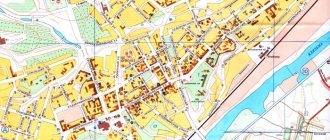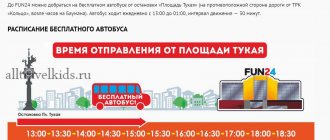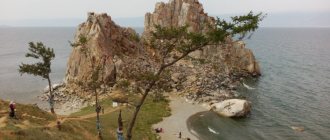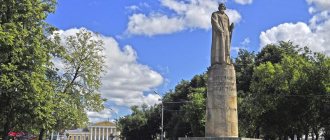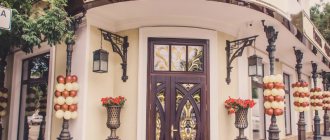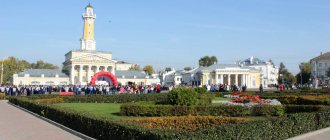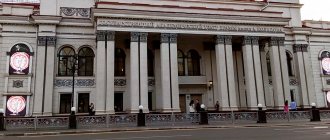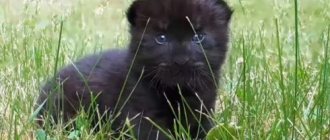Ride a dog sled, weave a beetle from a willow twig, see the stars and plunge into the atmosphere of a fairy tale come to life: we tell you where to go and what to do in winter in Kostroma with children. Go!
Kostroma is called the birthplace of the Snow Maiden thanks to the playwright Alexander Ostrovsky. It was he who composed a play about a heroine of folklore who melted from love, the prototype of which was the Slavic goddess Kostroma. This region is Ostrovsky’s land, which is why they decided to settle this snow sorceress here.
Advice: for your trip, choose a quiet weekend in January or February, when the main flow of visitors has subsided and the festive mood has not yet disappeared.
Visit the Snow Maiden
The log Terem of the Snow Maiden, where the New Year's sorceress welcomes guests all year round, is located on the picturesque bank of the Volga. Inside there is the atmosphere of a living fairy tale. Terem is located on Lagernaya street, house 38, next to the bridge over the Volga. According to the plot, the Snow Maiden is stingy with affection, but here, in Terem, the kids will feel real warmth.
The New Year's journey into a fairy tale has begun. From the city of Kostroma, dear to my heart. Actually, this is my mother’s homeland. But as it turned out, so did the Snow Maiden) Therefore, it was definitely decided to stop by for a visit. Although the Snow Maiden’s house is small, everything is very cozy and pleasant. And most importantly, fun and fabulous. It is very encouraging that tourism is being developed at least a little in Russia. So, you see, there will be other roads that simply don’t exist in Kostroma. And we moved on #New Year's trip 2018 #visiting Santa Claus #Snow Maiden's Tower #winter winter #New Year's mood #travel
Posted by Polina Panteleeva (@ppolishap) Dec 29, 2021 at 9:22 PST
The game entertainment program includes round dances with brownies and a cat named Bayun - the Snow Maiden's neighbors, as well as competitions, puppet shows and outdoor games. And here you can order a letter from the winter sorceress, which will arrive at the specified address in a “fairytale” envelope.
You can only walk around the Snow Maiden's Tower as part of a guided tour; there is no free visit. You can join the group, but most likely you will have to wait for some time. Therefore, it is worth planning your visit in advance, especially in January.
Be sure to check out the Ice Museum, where you can warm up with traditional Russian drinks. For adults, they are originally served in ice glasses. The museum is open all year round: you can visit it even in summer. You don’t have to worry about your clothes: “for warming up” they give you an embroidered sheepskin coat and felt boots.
Dessert at the Ice Museum, Snow Maiden's Tower
In the same courtyard as the Snow Maiden's Tower there is also a hotel of the same name, in whose restaurant New Year's shows are held every weekend in winter.
Two days in Kostroma
With a trip to this glorious city, we decided to continue our mini-series of trips to the Volga cities. On the first weekend of November, the road from Moscow took five and a half hours; we were delayed for an hour in the Pereslavl-Zalessky area due to road repairs.
We stayed at the Troya Hotel on Nikitskaya. On the topic of food, I recommend the Bravo-Star pizzeria chain, there are several of them in the city, the food is tasty and inexpensive. I compiled the excursion list, traditionally guided by reviews on the OSD.
Museum of Flax and Birch Bark
A private museum, opened relatively recently, in 2005, st. V. Tereshkova, house 38. 80 rubles adult ticket, 40 rubles for children, excursion for a group 200 rubles.
I recommend taking a tour – the stories and shows are very interesting.
The Flax Hall - a story about women's craft and a historical excursion. In 1866, Moscow merchants P.M., S.M. Tretyakov, V. Konshin and Kostroma merchant K.Ya. Kashin created the Partnership of the New Kostroma Linen Manufactory (NKLM). Kostroma factories were distinguished by a high technical level - the use of foreign-made mechanical machines, steam engines, and diesel engines.
The Birch Bark Hall – the products of modern birch bark makers who continue the traditions of the ancient craft are presented here. Our children enjoyed participating in a master class on making a rag doll-amulet (150 rubles). The museum also has an exhibition and sale of linen and birch bark products and souvenirs.
Ipatiev Monastery
Holy Trinity Ipatiev Monastery is a working monastery for men on the banks of the Kostroma River near its confluence with the Volga, st. Enlightenment, 1. Founded at the beginning of the 14th century in honor of the Most Holy Trinity and in the name of St. Hypatius, Bishop of Gangra, the monastery is rightfully considered one of the oldest in our Fatherland.
It was here that the glorious three-hundred-year reign of the House of Romanov began. In 1613, the monastery sheltered young Mikhail Romanov within its walls from the Great Troubles. From that moment on, the name was assigned to the monastery - “the cradle” of the House of Romanov.
In the chambers of the Romanov boyars in March 1613, during his call to the Moscow throne, Mikhail Fedorovich lived with his mother, the Great Elder Martha (in the world - Ksenia Ivanovna Romanova) in the Ipatiev Monastery. The Candle Building currently houses several exhibitions - the exhibition “Church Antiquities of the Kostroma Land. Treasures of Russian applied art of the 16th-19th centuries”, “Contributions of the boyar and royal family of the Godunovs”. In the Chambers of the Romanov Boyars there is an exhibition “Ipatiev Monastery - the “cradle” of the House of Romanov.”
Museum of Nature
We visited the exhibition “Nature of the Kostroma Region”, which included the exhibitions “Birds and Animals of the Kostroma Region”, “Stone Chronicle of the Kostroma Region”. On the second floor there is a collection of insects by I.M. Rubinsky. There is a petting zoo on the third floor - children are delighted with the visit! Located at: st. Milk Mountain, 3
Romanov Museum
Opened in 1913 by the Sovereign Emperor Nikolai Romanov himself, the building initially served as a museum - the museum of the Imperial Family. Currently, several exhibitions are presented here - “Kostroma Boyars - Personnel for the Throne”, “Three Centuries of Art”, “Creativity of Efim Chestnyakov. Tickets are inexpensive, 80 rubles each, but each exhibition requires a separate ticket. Also presented is a unique exhibition project “Salvador Dali. Located at: Mira Avenue, 5.
The Holy Message" is 105 works by the artist, his illustrations for the Old and New Testaments from a private Italian collection. A ticket to this exhibition is 300 rubles. The general impression of visiting the museum was that it had a rich exhibition, but nothing really interested the children.
The mansion of the Noble Assembly, Mira Avenue, 7, made a completely different impression.
Luxuriously! Here is an exhibition dedicated to the celebration of the 300th anniversary of the ruling Romanov dynasty. Kostroma, the cradle of the Romanov dynasty, became one of the centers of anniversary celebrations in 1913. On May 19-20, 1913, Emperor Nicholas II and his family arrived in the city.
Exhibition “Provincial Stories. The Highest Visit" tells about Kostroma and the province of the early twentieth century - about how it prepared for the anniversary celebrations, how the highest visit took place, how the Kostroma residents greeted the guests, about the first persons of the province and prominent Kostroma residents who met Nicholas II. You can really feel the spirit of the holiday here, the exhibits are very beautiful and the building in general amazes with its luxury.
We were attracted to the Guardhouse building (Lenin St. ½) by the exhibition “Small Arms of the 20th Century (private collection).”
Here are presented pistols, submachine guns, rifles and machine guns that were and are in service in many countries around the world: the Israeli Uzi submachine gun, the German MG-34 single machine gun, several modifications of the American Thomson submachine gun, unique examples of the heavy machine gun Degtyarev, Kalashnikov AKM “Green Border Guard” assault rifle, Mauser pistol (Chinese order). In addition, at the exhibition you can get acquainted with small arms from Great Britain, Germany and Czechoslovakia.
The guardhouse was built in 1823-1826. year according to the project of the provincial architect P.I. Fursova on the site of the former wooden one. The building is richly decorated; Its stucco decoration contains mainly symbolic military motifs associated with the victory in the War of 1812: armor, shields, as well as mascarons in the form of lion faces, dogs and crayfish.
Next to the guardhouse building there is the Kostroma Fire Tower. This building is often depicted as a symbol of the city of Kostroma.
The fire tower is an architectural monument of the first third of the 19th century, located on the main (Susaninskaya) square of Kostroma, and is its high-rise dominant feature. The initiative to build a tower on the central square (then called Yekaterinoslavskaya) belonged to Governor K.I. Baumgarten, whose order dated January 10, 1824 stated: “It does not interfere with a decent tower here, which would at the same time serve as a decoration for the city, and protect every inhabitant with safety during fire incidents.”
The author of the building project was the provincial architect P.I. Fursov. The convenient location of the monument, the integrity and compactness of the architectural volume, the expressiveness of its silhouette, and the measure in the use of decoration on the facade make the Kostroma tower one of the best monuments of late classicism in Russia. In 1834, it aroused the admiration of Emperor Nicholas I, who visited Kostroma, after which it acquired the reputation of the best fire tower in the Russian province. and are in service with many.
Currently, the Kostroma Regional Fire-Technical Exhibition is open in the tower building, from 11 to 16 o'clock, adult ticket 70 rubles, reduced price 50 rubles, children free, photography 30 rubles. The exhibition occupies two floors, I really liked it! Here is the history of the creation and development of the All-Russian Voluntary Firefighting Society, and various examples of fire and auxiliary equipment, and the history of the Kostroma fire department itself.
We didn’t get to the Snegurochka Terem (on Lagernaya Street) because... I was too lazy to sign up in advance, and at the time of our visit there were no free seats for the interactive program, but there are simply no tours of the tower and single visitors are not allowed to enter there. But we weren’t even upset by this fact. We walked along the embankment and visited Ostrovsky's gazebo.
The general impression is a cute provincial town, the roads are terrible, even in the very center of the city. However, there are no problems with hotels and food; there is a cafe or restaurant on almost every street. Souvenirs included linen towels purchased at the Linen Museum and black salt.
https://www.osd.ru
Go to a fairyland
The Kostroma sorceress also has a winter residence in the city - “The Fairytale Land of the Snow Maiden”. It is a small museum dedicated to Russian folk tales, traditions and rituals. Here you can spend hours looking at the details: handmade doll dresses decorated with embroidery, Christmas tree decorations, amulets from all the provinces of Russia and household items. You can touch all the exhibits with your hands - the kids are delighted! There is also a lot of interactivity here: you can send the pot to the stove using a grip or grind grains in a millstone.
However, it is not only the gaming program that is of interest. The museum building is a former salt shop that flourished in the 19th century. And very close by are the gates of the Moscow Outpost, which were erected for the arrival of Catherine II in Kostroma.
Address: Simanovsky Street, building 11. You can get to the residence by public transport by minibus No. 4. Or walk. Along the way, pay attention to the buildings of the Znamensky Monastery.
Museum of Wooden Architecture
Nowadays wooden houses are very fashionable and look great. But it is expensive, not everyone can afford to build a hut from real wood. But before, the whole city was made of wood. But because of this, tragedies and fires often occurred.
But Kostroma was still being rebuilt. But, interestingly, there is not a single ancient wooden building in the entire city. But people wanted children to know what the city looked like before, how people lived.
Therefore, at least some surviving wooden architectural monuments began to be brought to Kostroma from all over the region.
An unusual museum has been opened since 1958. What makes it unusual is that all the exhibits are stored not within the walls of the building and behind glass, but directly in the open air.
Be sure to go there with your children. Tell them that the houses were brought here disassembled. They were assembled on site and furnished inside as they had done before.
The children will learn a lot of interesting things about various household items, their purposes, and even see how a real ancient loom works.
Hug the bronze dog
A Basset dog named Bobka is a legend of the Kolomna fire department, which is still located not far from Susaninskaya Square. In the 19th century, the dog lived in the Fire Tower, was a member of the fire brigade and helped save Kostroma residents from fire. The whole city spoke about her exploits: Bobka became such a noticeable phenomenon that she became the hero of a story by local writer Leonid Kolgushkin.
“The departure of the main fire department was always accompanied by a large, red, shaggy dog named Bobka. She was a common favorite of all fire workers. They said that during fires Bobka more than once carried children and belongings out of burning premises. At the sound of the fire bell, this permanent duty officer was the first to jump out of the open gate and always ran to the side of the lead team.”
Posted by Maria Kazinskaya (@mariakazinskaya)Nov 25, 2021 at 11:20 PST
In memory of the brave rescuer, a bronze monument was erected in 2006. In winter, this absolutely charming bronze figure is decorated with a scarf so that Bobka does not freeze. The dog continues to help the townspeople today: he guards a piggy bank in the shape of a ball, where you can throw coins and bills. All money raised goes to help a shelter for homeless animals. And if you sit on a dog’s back and pet it, they say your most cherished wish will come true.
The times of Dmitry Donskoy
The lands of the Vladimir princes gradually expanded. This, accordingly, helped strengthen their power. But this state of affairs did not suit the Horde khans.
And so in 1327 the Horde khan intervened and divided the Vladimir lands into parts. Novgorod and Kostroma went to Prince Ivan Danilovich Kalita. It turned out that the city of Vladimir was given to someone else. Kostroma has always been connected with him. And Kalita was a Moscow prince.
But under Dmitry Donskoy, a lot has changed. Previously, the Principality of Moscow, which included Kostroma, was not in the best position due to the impossibility of communication with the Volga route.
But Prince Dmitry began to use Kostroma, bypassing the Volga route. Kostroma even became a refuge from Khan Tokhtamysh for Prince Donskoy. A brief history of the city for children includes a story about the Kostroma Kremlin.
Get lost in the “Wonder Forest”
On Ostrovsky Street, on the banks of the Kostroma River, there is an unusual fairy tale house, the entrance to which is guarded by Mishka the Bear. This place is the “Wonder Forest” museum. The atmosphere of forest myths and legends envelops you right from the door: here you can learn about the Kostroma forests and their fabulous inhabitants - goblin, kikimoras, merman and mermaids. Here you can find the traditional hut of Baba Yaga and the exotic Stump-Evert. It is curious that most of the exhibits are created entirely from natural materials - vines, tree trunks and branches. A separate room is dedicated to blacksmithing. In addition, by visiting the “Wonder Forest”, kids will get an idea of what wood carving, willow weaving and artistic forging are.
Posted by @muzey_les_chudodeyMar 19, 2021 at 11:31 PDT
“The magnificent works of local wood craftsmen in a fairy-tale style tell about the forest - the main wealth of the Kostroma region. Wonderful guides who love their region will introduce you and your children to fabulous forest inhabitants, the roots and trunks of trees will turn into heroes of fairy tales, you will feel the warmth of pine, linden, birch wood and will be amazed by the excellent technique of wood carving masters using various tools. Magnificent works of masters of weaving from bast, straw, wicker and birch bark. The creative work of metal craftsmen (forging and plasma cutting) is impressive.”
Review by user Kostas C about the “Wonder Forest” museum on TripAdvisor.
The museum hosts master classes on making a beetle from a willow twig, although only for groups of ten or more people. They are worth booking in advance.
A few more interesting places
Kostroma, an ancient Russian city located on the banks of the Volga, was founded in 1152. Over its almost thousand-year history, it has absorbed the best examples of architectural and spiritual heritage, becoming a kind of religious and ethnographic Mecca for those who want to touch the history of Ancient Rus'.
This uniquely beautiful city, located 300 km from Moscow, is included in the main route of the Golden Ring. It is famous not only for the well-preserved examples of wooden architecture in its center, but also for many historical events that had a strong influence on the formation of the Russian state and the fate of the country.
Excursion tours
In addition to sightseeing tours of the cities of the Golden Ring, it offers special tours to this ancient city, allowing you to get to know its history and unique attractions better.
Do you have a limited amount of time and are deciding what to see in Kostroma in 1 day? One-day sightseeing tours are at your service, which include visits to the main attractions and a short excursion to the main historical events that once unfolded in these places. You will get acquainted with examples of ancient architecture, learn about the events of the troubled times, the expulsion of False Dmitry II, as well as the feat of local militias.
Do you have a lot of time and would like to spend your weekend usefully? And in this case, there will be something to see in Kostroma in 2 days. The extended excursion program includes visits to religious buildings, museums and architectural monuments of various eras. The variety of attractions makes this tour interesting for both adults and children.
For relaxation, comfortable hotel rooms are provided, as well as nutritious meals.
Where to go with the whole family?
Among the abundance of museums, monuments and other cultural sites, it is very easy to get lost, because you so want to see everything at once. However, this is not worth doing: it is better to return to this wonderful city again, choosing a specific theme for each trip.
The choice of route will depend on many factors:
- number of free days;
- presence of children;
- desires to explore specific cultural and historical attractions;
- pilgrimage or not.
In each of these cases, the route may be very different.
Best places
These picturesque places have long been famous for their masters of wooden architecture and skilled carvers, which made the city one of the centers of development of Byzantine art. However, it is famous not only for its architecture, but also for its unique museums and entertainment routes for children.
Holy Trinity Ipatiev Monastery
Founded in 1330, the monastery is famous for the history of its origin. According to the official version, it was founded by a Tatar Horde military leader who fled from the khan to Prince Ivan Kalita. Having accepted the name Zachary in baptism, he miraculously received healing from a serious illness from the Mother of God who appeared to him in a vision, accompanied by the apostles.
In gratitude for the healing, a men's monastery was created on the banks of the river. The monastery survived the Time of Troubles, but during Soviet times it was abolished, and the churches were completely destroyed. Later, an architectural museum-reserve was created on its territory.
The revival of the monastery began only in 1989, when the first services were held there. The monastery complex includes a complex architectural ensemble of walls and towers of the New and Old Towns, the Trinity Cathedral Church, a belfry and restored historical objects of the 16th-19th centuries.
Museum of Wooden Architecture
The universal answer to the question of what to see in Kostroma is a visit to the Kostroma Sloboda Museum, located near the South and North walls of the Ipatiev Monastery. The history of the museum’s creation begins in the middle of the last century, when, as a result of the construction of the reservoir and dam of the Gorky hydroelectric station, ancient monuments of wooden architecture were under the threat of flooding.
The first to be moved to the new location was the unique Church of the Transfiguration, built back in the 18th century. Gradually, the exhibition was replenished with baths, barns, mills and other architectural objects of antiquity.
Susaninskaya Square
The central square, where the monument to Ivan Susanin is located. At the beginning of 1918, it was destroyed by the Bolsheviks, but in 1967 it was re-installed on the territory of the destroyed chapel. There is also a guardhouse building and a stone fire tower, recognized as the most beautiful in the country.
The Snow Maiden's Tower
A wonderfully beautiful place where you can go with a child in Kostroma. Playwright Alexander Ostrovsky, while once in these parts, wrote his famous fairy tale “The Snow Maiden” here, as a result of which the Kostroma province became the official homeland of the fairy-tale beauty.
Monument to Yuri Dolgoruky
Sights in Kostroma date back not only to the ancient era, but also reflect modern realities. Thus, the monument to Yuri Dolgoruky was founded in 2003 in honor of the celebration of the 850th anniversary of the city as a tribute to the memory of the founder. A massive sculpture weighing 4 tons and 4.5 meters high is installed on Resurrection Square.
Kostroma Zoo
Another exciting place where you can go with the whole family, taking even the little ones with you. This zoo is very young; it was opened in 2010 as part of the city’s anniversary celebrations and immediately won the love of residents. The area is slightly more than 90 hectares, on which enclosures with animals and walking areas are located. The exhibition is constantly updated with new inhabitants and includes both the usual animals of the middle zone - foxes, bears and wolves, and exotic ostriches and lions.
Theater Costume Museum
A museum of theatrical costume has been opened at the Kostroma Drama Theater, which contains exhibits created for performances over the past 100 years, as well as new clothes for modern productions. In the exhibition halls, ancient noble interiors are recreated, helping to feel the spirit of a bygone era. There is also a photo exhibition on a regular basis, reflecting the evolution in theatrical costume over the past decades.
Kostroma Exotarium
If you are in doubt about where to go in Kostroma on the weekend, visit an exhibition of exotic animals collected from all over the world. Spiders, frogs, snakes, parrots, lizards and rodents will not leave either children or adults indifferent. There are also demonstration feedings, thematic exhibitions and lectures that introduce the living conditions of animals and reptiles in the wild, their characteristics and habits.
Museum of unique dolls and toys
This exhibition will be of interest to visitors of any age. The museum's collections contain more than 2,000 antique exhibits: porcelain and wax dolls, doll household items and various accessories, including toy ethnic costumes.
In addition, the exhibition presents the famous Teddy bears, toys from the Soviet period and various designer products. Thematic master classes are held very often.
Where else to go?
A holiday in this ancient Russian city can be a truly interesting family outing, because here everyone will find something to suit their interests. Little travelers will be interested in visiting the amusement park, racing track and rope town. Those who love creativity will enjoy master classes on making chocolate and clay toys. An excursion to the petting zoo will be a unique experience of communicating with wildlife.
Also, children who permanently live in an urban environment will be interested in visiting the eco-village “Znatnaya Storonka” and get acquainted with the rural way of life, see domestic animals and birds and learn about the life of rural residents.
History and spirituality in modern realities
Now you know what attractions there are in Kostroma. The ancient city, which has absorbed the best examples of Russian culture and art, still keeps many mysteries and secrets that anyone can discover by visiting it on a tour and choosing a program to their liking.
Pilgrimage tours, family trips with children, excursions for adults interested in the history and wildlife of their native land will be an excellent solution for a family vacation. Make the most of your weekend with excursion tours from . Comfortable buses and hotels, rich tourist programs and a sea of new impressions await you. Contact us!
https://horizonty.ru/
Go ice skating at Berendeyevka
You can go dog sledding and ice skating, walk through the winter forest and go ice fishing in the Berendeyevka pine and birch park. It is located a ten-minute drive from the historical center of Kostroma. There are three ponds on the territory. In the 1960s, about ten houses were moved here, which were built specifically for the filming of the legendary Soviet fairy tale film “The Snow Maiden” based on the work of the same name by Ostrovsky.
Posted by @berendeevka44Dec 16, 2021 at 2:01 PST
True, most of them were destroyed in the 1990s. However, here in the village you can still plunge into the atmosphere of a real fairy tale: take a look at the Berendeyevka tower restaurant, whose interiors are decorated in the Old Russian style. There is a children's menu.
Oh, this Berendeyevka! Her famous cheeses and approach to clients leave no one indifferent. After their master class, our yoginis bought all the cheese (although almost no one had planned to do this before). And for the final lunch they made us our favorite momas with cheese and spinach. Enjoyed it at the highest level! #yogatour #voyagewith meaning #Berendeyevka #obzhorkintour
Posted by Tatyana Glushkova (@tanya_glushkova36) Jan 7, 2018 at 10:51 PST
Ipatiev Monastery
Of course, the first thing you should see in Kostroma is the famous Ipatiev Monastery, which was founded in the 14th century. Here you can take a journey into the depths of ancient Russian history
.
The territory of the monastery is divided into two parts - the Old Town (1586-1590), and the New Town, built half a century later by order of Mikhail Romanov. Access to the territory of the New City is closed. The center of the monastery is the Trinity Cathedral
and the nearby high
belfry
.
Ipatiev Monastery - the main attraction of Kostroma
The territory that is accessible to tourists in the Ipatiev Monastery is small, so you will have enough time to visit the Kostroma Architectural, Ethnographic and Landscape Museum-Reserve “Kostromskaya Sloboda”,
located just south of the monastery.
In this picturesque museum you can see preserved wooden buildings from the 16th to 19th centuries
.
Museum of Wooden Architecture "Kostromskaya Sloboda"
After you have become familiar with the ancient Russian history of Russia, you can take a minibus across the bridge over the Kostroma River to Susaninskaya Square,
and move on to the second part of getting to know the city, namely, getting to know the historical and architectural appearance
of the merchant
city
of the 18-19 centuries
and the museums of modern Kostroma.
See the stars
However, you can watch not only fairy-tale characters in Kostroma. You can see very real stars from a very real telescope if you look into a very real planetarium. “Star House of Kostroma” is one of the oldest in Russia, it was opened in 1951. Moreover, in the building of a former church. In the foyer hangs a model of the first artificial Earth satellite, which was launched on October 4, 1957. The planetarium hosts lectures on astronomy and children's fairy tale performances about stars, planets, meteorites and comets. Most programs are designed for children and schoolchildren.
Advice: the people at the Kostroma Planetarium are truly fans of their craft, so you can and should ask questions here. The Star House welcomes everyone who is passionate about astronomy and the world around them.
Kostroma is clean air and water
Now many large, and not only large, cities suffer from polluted air and poor ecology. If you just want clean air and want to make your children healthier, then be sure to go to Kostroma.
Suffice it to say that:
- Kostroma is one of the ten most environmentally friendly cities in Russia.
- The air is clean here.
- Nature is stunning in its uniqueness and originality.
- There is a nature reserve on the territory of Kostroma, where your children can see with their own eyes a bunny, a fox, as well as centuries-old trees. Experienced guides will definitely tell you that these plants are about 400 years old.
Pizza, pasta and soap bubbles
Family trattoria "Pinocchio" (Sovetskaya street, building 59) is ideal for families with children. The menu includes dishes of Italian and Japanese cuisine, as well as everything that kids adore. On Sundays from 12:00 to 14:00, animation programs with master classes are held at Pinocchio. The rest of the time, all little visitors are given coloring books, soap bubbles and pencils. The portions in the trattoria are large. There is a separate children's menu. Be sure to try the chocolate fondant - they make it excellent here.
“This year the trattoria offered a master class on making gingerbread cookies. The children were delighted. Although the company was of different ages - from 4 to 14 years old, absolutely everyone coped with the task, for which many thanks to the presenter Yulia! As always, “Pinocchio” delighted the kids with desserts and the most delicious pizza in the city!”
Review from user Mary_Mik23 about the Pinocchio trattoria on TripAdvisor.
Master class at the family trattoria “Pinocchio”
Back to the past
Kostroma is an ancient city, which is more than 900 years old. Just imagine, a little more, and the city will celebrate its millennium.
Back in 1213, the city was completely destroyed by fire. All its inhabitants who were still alive, young and old, were taken captive.
Why, who took the residents captive? The history of Kostroma for very young children may well be like this. A prince named Constantine captured the city that belonged to his brother. Of course, because Konstantin was the older brother. And at that time, whoever is older should rule.
Kostroma has always been a tasty morsel. The princes always wanted the city to belong to them. The princes of Vladimir placed their eldest sons on the throne, hoping that the city could always become a fortress and a place of refuge from enemy invasions.
Sumarokovskaya elk farm
Kostroma region, Krasnoselsky district, Sumarokovo village
Official site
https://www.loseferma.ru
The moose farm is located about 20 km from Kostroma. It began its work in 1963 and continues to this day. During the excursion, you and your children will be able to observe the life of moose. Ideal conditions have been created here for these cute animals. The elk on the farm live freely, that is, if they want to go into the forest, no one will stop them, and no one will be forced to keep them in the reserve. The animals are monitored through modern sensors, each device is attached to the neck, and workers use signals to determine the location of the elk.
The excursion includes a sightseeing walk around the farm, as well as a fascinating story about the life of moose and their habits. If you would like to take memorable photographs with an animal, it is best to consult with a farm staff member first.
